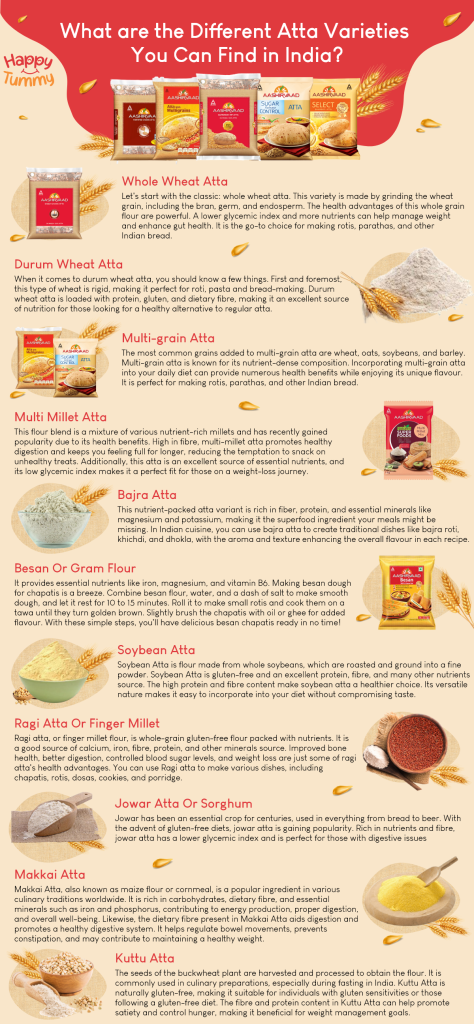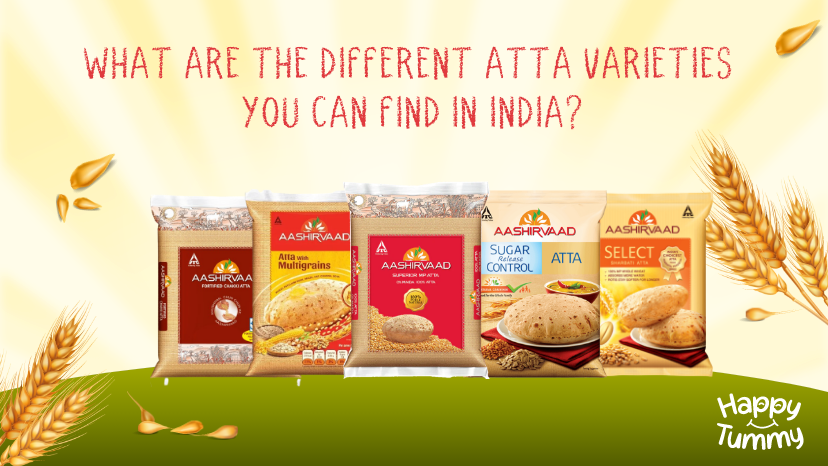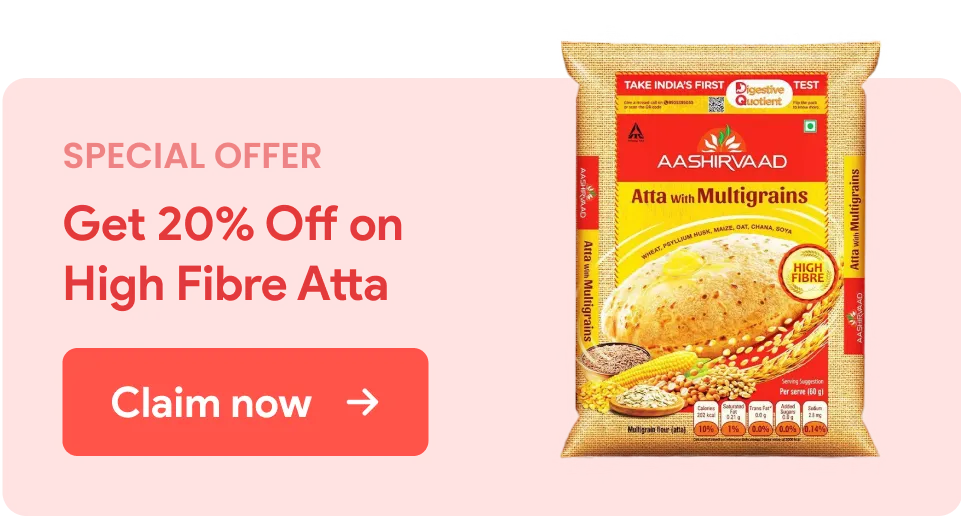Table of Contents
The modest chapatti is a mainstay in all Indian homes since it is simple but bursting with flavour and nutrients. Chapattis are made from flour or more famously known as atta. In India’s diverse and vibrant culinary landscape, atta holds a significant place.
Even the idea of meals without the comforting familiarity of chapattis can seem lacking; whether dal or gravy, our meals will not taste the same without the beloved companion, chapatti.
However, many may not realize that atta comes in different varieties, each with its own distinct characteristics and benefits. In this blog, we will take a delightful journey through some of India’s most popular atta varieties.
Types of Atta

1. Whole Wheat Atta
Let’s start with the classic: whole wheat atta. This variety is made by grinding the wheat grain, including the bran, germ, and endosperm.
The health advantages of this whole grain flour are powerful. A lower glycemic index and more nutrients can help manage weight and enhance gut health [1].
Plus, it adds texture and flavour to your treats. It is the go-to choice for making rotis, parathas, and other Indian bread.
You can try Aashirvaad Whole Wheat Atta or Aashirvaad Sugar Release Control Atta
2. Durum Wheat Atta
When it comes to durum wheat atta, you should know a few things. First and foremost, this type of wheat is rigid, making it perfect for roti, pasta and bread-making.
Durum wheat atta is loaded with protein, gluten, and dietary fibre, making it an excellent source of nutrition for those looking for a healthy alternative to regular atta [2].
The making process of Durum wheat atta is quite similar to chakki atta, but with a few key differences. The wheat kernels are cleaned and sorted before being tempered with water to soften the outer bran.
Once softened, the wheat is run through roller mills to create a fine atta powder. You may make pasta, spaghetti, and even pizza from durum wheat atta in Indian cooking.
3. Multi-grain Atta
You’ve probably heard of multi-grain atta if you’re a healthy food enthusiast. This type of atta combines two or more ground grains to make flour.
The most common grains added to multi-grain atta are wheat, oats, soybeans, and barley. Multi-grain atta is known for its nutrient-dense composition. Incorporating multi-grain atta into your daily diet can provide numerous health benefits while enjoying its unique flavour.
It is perfect for making rotis, parathas, and other Indian bread.
Remember that choosing the right atta is essential for your health. Multi-grain atta has multiple advantages over regular atta, so it’s definitely worth trying.
Aasirvaad Atta with Multigrains
AASHIRVAAD ATTA WITH MULTIGRAINS is here to help you if you want to avoid the effort of making multi-grain atta while also without compromising your health.
You can have the nutritional goodness of six different grains—wheat, soya, channa, oat, maize, and psyllium husk—in one package from AASHIRVAAD Atta with Multigrains.
The high fibre content of atta aids in maintaining healthy digestion. So, try using multi-grain atta in your cooking, and experience its incredible health benefits.
Aasirvaad Sugar Release Control Atta
However, if you have diabetes, you can choose AASHIRVAAD Sugar Release Control Atta, a unique “Special Grain Mix” made of whole wheat flour, pulse, and legume flours.
Oats and methi are two ingredients that make this atta high in protein and fibre and low in glycemic index. It releases its sugar slowly in the body and thus helps in preventing sugar level spikes.
4. Multi Millet Atta
This flour blend is a mixture of various nutrient-rich millets and has recently gained popularity due to its health benefits.
High in fibre, multi-millet atta promotes healthy digestion and keeps you feeling full for longer, reducing the temptation to snack on unhealthy treats.
Additionally, this atta is an excellent source of essential nutrients, and its low glycemic index makes it a perfect fit for those on a weight-loss journey.
Aashirvaad Multi Millet Mix
Are you looking for the perfect multi-millet mix? Try Aashirvaad Multi Millet Mix, which combines the wholesome goodness of all the necessary millet grains to give you and your family the finest possible experience at every meal. Give it a try and see the difference in your health and cooking!
5. Bajra Atta
We all know the struggle of choosing a healthy and nutritious option for our daily meals, but what if we told you that you can have your chapatis and eat them too?
Enter bajra atta, the perfect substitute for those that want to switch things up.
This nutrient-packed atta variant is rich in fiber, protein, and essential minerals like magnesium and potassium, making it the superfood ingredient your meals might be missing [3].
The nutty flavour profile and coarser texture make bajra atta a popular choice for individuals aiming to add more depth to their recipes.
In Indian cuisine, you can use bajra atta to create traditional dishes like bajra roti, khichdi, and dhokla, with the aroma and texture enhancing the overall flavour in each recipe.
You can also use Bajra atta as a binding agent in various snacks, making it an all-rounder ingredient for multiple recipes.
So the next time you crave some roti and sabzi, consider opting for bajra atta for a change. Your taste buds and body will thank you.
6. Besan Or Gram Flour
Besan or gram flour is another common atta that is part of every home; used as an ingredient in various recipes, besan sure adds variety to the plate. It provides essential nutrients like iron, magnesium, and vitamin B6 [4].
Making besan dough for chapatis is a breeze. Combine besan flour, water, and a dash of salt to make a smooth dough, and let it rest for 10 to 15 minutes.
Roll it to make small rotis from Aashirvaad Besan and cook them on a tawa until they turn golden brown. Slightly brush the chapatis with oil or ghee for added flavour. With these simple steps, you’ll have delicious besan chapatis ready in no time!
7. Soybean Atta
It is flour made from whole soybeans, which are roasted and ground into a fine powder. Soybean Atta is gluten-free and an excellent protein, fibre, and many other nutrients source [5].
The high protein and fibre content make soybean atta a healthier choice. Its versatile nature makes it easy to incorporate into your diet without compromising taste.
Combine soybean atta with whole wheat flour in your regular chapati dough.
You’ll hardly notice the difference in taste but will surely feel the difference in nutrition! You can also use soybean atta to make soft and fluffy pancakes or add it to your favourite smoothies for a protein boost.
8. Ragi Atta Or Finger Millet
Ragi atta, or finger millet flour, is whole-grain gluten-free flour packed with nutrients.
For decades, ragi has been a staple dish in many Indian homes, mainly in rural areas. It is a good source of calcium, iron, fibre, protein, and other minerals source.
Improved bone health, better digestion, controlled blood sugar levels, and weight loss are just some of ragi atta’s health advantages [6].
Incorporating Aashirvaad ragi atta into your diet can be an excellent way to lead a healthier lifestyle. You can use Ragi atta to make various dishes, including chapatis, rotis, dosas, cookies, and porridge.
9. Jowar Atta Or Sorghum
Who says ‘healthy’ can’t be ‘yummy’? Jowar atta, made from the gluten-free, versatile jowar grain, is here to prove the naysayers wrong. Jowar has been an essential crop for centuries, used in everything from bread to beer.
With the advent of gluten-free diets, jowar atta is gaining popularity. Rich in nutrients and fibre, jowar atta has a lower glycemic index and is perfect for those with digestive issues [7].
Jowar atta is versatile, and you can use it in various recipes. Use it in making rotis, parathas, or other flatbreads to add a nutritious touch. You can also use it in making porridge and delicious soups and stews.
For gluten-free snacks and baked goods, jowar atta is an ideal substitute for wheat flour. Try out new recipes and experiment with jowar atta to get the most out of its nutritional value. Your taste buds and health will thank you for it!
10. Makkai Atta
Makkai Atta, also known as maize flour or cornmeal, is a popular ingredient in various culinary traditions worldwide.
It is derived from dried and ground corn kernels and offers several benefits regarding nutrition and versatility.
It is rich in carbohydrates, dietary fibre, and essential minerals such as iron and phosphorus, contributing to energy production, proper digestion, and overall well-being.
Likewise, the dietary fibre present in Makkai Atta aids digestion and promotes a healthy digestive system.
It helps regulate bowel movements, prevents constipation, and may contribute to maintaining a healthy weight. You can manage your weight more effectively by including Makkai Atta in your meals.
In Indian cuisine, it is commonly used to prepare staple foods such as makki ki roti (cornmeal flatbread) and corn-based snacks like dhokla and pakoras. You can also use it to thicken soups, stews, and sauces or as a coating for frying.
11. Kuttu Atta
Kuttu Atta, or buckwheat flour, is made from the seeds of the buckwheat plant, scientifically known as Fagopyrum esculentum.
Despite its name, buckwheat is not a cereal grain but a pseudocereal. The seeds of the buckwheat plant are harvested and processed to obtain the flour.
The process involves removing the outer husk or shell of the seeds to reveal the edible portion, which is then ground into a fine powder to create Kuttu Atta.
The resulting flour has a distinct light brown colour and a slightly nutty flavour. It is commonly used in culinary preparations, especially during fasting in India.
Kuttu Atta is naturally gluten-free, making it suitable for individuals with gluten sensitivities or those following a gluten-free diet.
The fibre and protein content in Kuttu Atta can help promote satiety and control hunger, making it beneficial for weight management goals. Adding Kuttu Atta to your meals can enhance their nutritional value.
You can incorporate it into regular chapati dough to make it more nutritious or use it as a thickener in soups and stews.
Whether you’re looking for a gluten-free option or want to incorporate more nutrients into your meals, Kuttu Atta is a versatile and nutritious choice.
Also read – How to keep your atta fresh ?
The Bottom Line
Ultimately you can find a treasure trove of flavours, textures, and nutritional advantages in the diverse range of atta types utilized in Indian cuisine.
The nutrient-dense whole wheat atta, elastic durum wheat atta, nutrient-dense multi-grain atta, earthy barley atta, calcium-rich ragi atta, and gluten-free maize atta are just a few varieties of atta that each has unique characteristics that set them apart from one another.
You can enhance the flavour and texture of your meals and add a variety of nutrients to our diets by embracing this diversity.
Therefore, let’s savour in the countless atta types’ culinary delights while honouring our traditions and embracing a tasty and healthy future.
FAQs
Yes, atta varieties, whole wheat atta and multi-grain atta varieties are generally considered healthier than refined flour. They contain higher amounts of fiber, vitamins, minerals, and antioxidants.
To keep atta fresh, store it in an airtight container in a cool, dry place away from direct sunlight. Moisture and heat can cause the flour to spoil or develop an unpleasant odour. It’s also advisable to check the expiration date and use the atta within the recommended timeframe for the best quality and taste.















